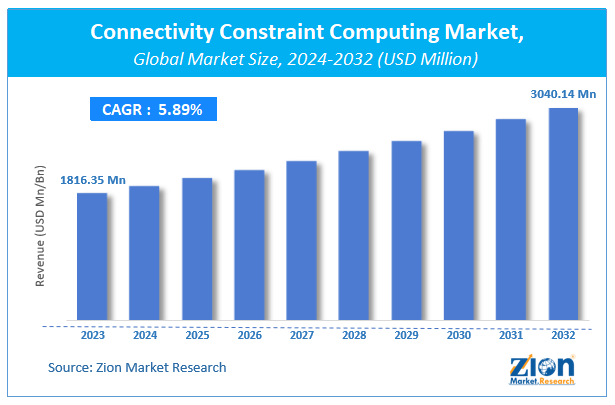Connectivity Constraint Computing Market Size, Share, Growth & Forecast 2032

Connectivity Constraint Computing Market By applications (ecosystem & healthcare management systems, social management, logistic & other network designing, and security) And By Region: - Global And Regional Industry Overview, Market Intelligence, Comprehensive Analysis, Historical Data, And Forecasts, 2024-2032
| Market Size in 2023 | Market Forecast in 2032 | CAGR (in %) | Base Year |
|---|---|---|---|
| USD 1816.35 Million | USD 3040.14 Million | 5.89% | 2023 |
Description
Connectivity Constraint Computing Market Insights
According to the report published by Zion Market Research, the global Connectivity Constraint Computing Market size was valued at USD 1816.35 Million in 2023 and is predicted to reach USD 3040.14 Million by the end of 2032. The market is expected to grow with a CAGR of 5.89% during the forecast period. The report analyzes the global Connectivity Constraint Computing Market's growth drivers, restraints, and impact on demand during the forecast period. It will also help navigate and explore the arising opportunities in the Connectivity Constraint Computing industry.
Global Connectivity Constraint Computing Market: Overview
Connectivity constraint computing is widely used for geospatial identifications, image recognition, and network designing. The connectivity constraint tools enable the user to minimize the time of analysis, and make quick & precise decisions. In addition to this, it also supports resolving multiple constraints simultaneously and is used in custom dynamic constraint modeling.
Global Connectivity Constraint Computing Market: Growth Factors
The global connectivity constraint computing market is growing at a speedy rate owing to factors such as the growing need to solve connectivity issues, growing demand for better methods for wildlife preservation, and an increase in research & development activities. Further, there is growing necessity for healthcare management which has led to an increase in focus on meaningful innovation which is been enhanced by business ecosystem. In addition to this, there is increase in connectivity requirements for forest planning models. This has led to the adoption of connectivity constraint computing in several industries including network designing, healthcare, and ecosystem. In addition to this, to meet the growing demand for connectivity constraint computing, key players are heavily investing in the development of infrastructure.
A significant increase in the number of smart city projects and growing need for the state-of-the-art ecosystem are surging the adoption of connectivity constraint computing tools. All such factors are effectively contributing to the growth of the global connectivity constraint computing market. In addition to this, the growing use of data-driven decision systems and growing acceptance of connectivity constraint computing to identify low-cost designing & lower production costs are some of the additional factors that are propelling the growth of the global market. Moreover, strategic collaborations among the key players for business expansion is further fueling the market growth.
Furthermore, increase in the use of advanced technologies to modify the software may generate lucrative opportunities for the growth of the global connectivity constraint computing market during the forecast period. However, the high cost and a large amount of time taken to collect data may restrain the growth of the global connectivity constraint computing market.
The onset of the COVID-19 pandemic has moderately affected the growth of the global connectivity constraint computing market. Though few inconsequential damages halted the growth of the connectivity constraint computing market to some extent. The market is expected to surge with a healthy growth rate during the pandemic period. In addition to this, with the occurrence of pre-pandemic conditions the global connectivity constraint computing market is expected to grow at a significant rate over the forecast period.
Global Connectivity Constraint Computing Market: Segmentation
The global connectivity constraint computing market is bifurcated based on applications and region.
Based on application, the global connectivity constraint computing market is bifurcated into ecosystem & healthcare management systems, social management, logistic & other network designing, and security.
Among these applications, the ecosystem & healthcare management system segment is expected to hold the maximum share of the market during the forecast period. The segment is contributing significant revenue in the overall market owing to wider applications of connectivity constraint computing in the sector.
Connectivity Constraint Computing Market: Report Scope
| Report Attributes | Report Details |
|---|---|
| Report Name | Connectivity Constraint Computing Market |
| Market Size in 2023 | USD 1816.35 Million |
| Market Forecast in 2032 | USD 3040.14 Million |
| Growth Rate | CAGR of 5.89% |
| Number of Pages | 193 |
| Key Companies Covered | Google Inc., Wal-Mart Stores Inc., Microsoft Corporation, Amazon.com Inc., Oracle Corporation, TATA Consultancy Services, IBM Corporation, and Cognizant Technologies Solutions Corporation among others |
| Segments Covered | By applications and By Region |
| Regions Covered | North America, Europe, Asia Pacific (APAC), Latin America, Middle East, and Africa (MEA) |
| Base Year | 2023 |
| Historical Year | 2018 to 2022 |
| Forecast Year | 2024 - 2032 |
| Customization Scope | Avail customized purchase options to meet your exact research needs. Request For Customization |
Global Connectivity Constraint Computing Market: Regional Analysis
North America is expected to persist as the largest marker for connectivity constraint computing during the forecast period. Factors such as vast digitalization, presence of key players, and increasing awareness regarding digital service in key end use sectors are expected to drive the regional market growth. The U.S. is forecasted to remain the dominant market in North America in terms of revenue contribution. Asia Pacific is projected to be the most lucrative market for connectivity constraint computing during the forecast period. The rapid expansion of the market in emerging countries such as India and China is mainly contributing to the fast growth of the market. Among all China is forecasted to be the largest market in the Asia Pacific. Europe is also a major market for connectivity constraint computing and it is expected to grow at a healthy rate over the forecast period.
Global Connectivity Constraint Computing Market: Competitive Players
The global connectivity constraint computing market is dominated by major players, new market players are also expanding their capabilities by expanding their business reach in emerging countries. Some of the key players operating in the global connectivity constraint computing market include:
- Google Inc.
- Wal-Mart Stores Inc.
- Microsoft Corporation
- Amazon.com Inc.
- Oracle Corporation
- TATA Consultancy Services
- IBM Corporation
- Cognizant Technologies Solutions Corporation among others.
The Global Connectivity Constraint Computing Market is segmented as follows:
By applications
- ecosystem & healthcare management systems
- social management
- logistic & other network designing
- security
Global Connectivity Constraint Computing Market: Regional Segment Analysis
- North America
- The U.S.
- Canada
- Europe
- France
- The UK
- Spain
- Germany
- Italy
- Rest of Europe
- Asia Pacific
- China
- Japan
- India
- South Korea
- Southeast Asia
- Rest of Asia Pacific
- Latin America
- Brazil
- Mexico
- Rest of Latin America
- Middle East & Africa
- GCC
- South Africa
- Rest of Middle East & Africa
What Reports Provides
- Full in-depth analysis of the parent market
- Important changes in market dynamics
- Segmentation details of the market
- Former, on-going, and projected market analysis in terms of volume and value
- Assessment of niche industry developments
- Market share analysis
- Key strategies of major players
- Emerging segments and regional markets
- Testimonials to companies in order to fortify their foothold in the market.
Table Of Content
Choose License Type
FrequentlyAsked Questions
The global connectivity constraint computing market is growing at a speedy rate owing to factors such as the growing need to solve connectivity issues, growing demand for better methods for wildlife preservation, and an increase in research & development activities. Furthermore, increase in the use of advanced technologies to modify the software may generate lucrative opportunities for the growth of the global connectivity constraint computing market during the forecast period.
Some of the key players operating in the global connectivity constraint computing market include Google Inc., Wal-Mart Stores Inc., Microsoft Corporation, Amazon.com Inc., Oracle Corporation, TATA Consultancy Services, IBM Corporation, and Cognizant Technologies Solutions Corporation among others.
North America is expected to persist as the largest marker for connectivity constraint computing during the forecast period. Facts such as vast digitalization, presence of key players, and increasing awareness regarding digital service in key end use sectors. The U.S. is forecasted to remain the dominant market in North America in terms of revenue contribution.
HappyClients
Zion Market Research
Tel: +1 (302) 444-0166
USA/Canada Toll Free No.+1 (855) 465-4651
3rd Floor,
Mrunal Paradise, Opp Maharaja Hotel,
Pimple Gurav, Pune 411061,
Maharashtra, India
Phone No +91 7768 006 007, +91 7768 006 008
US OFFICE NO +1 (302) 444-0166
US/CAN TOLL FREE +1 (855) 465-4651
Email: sales@zionmarketresearch.com
We have secured system to process your transaction.
Our support available to help you 24 hours a day, five days a week.
Monday - Friday: 9AM - 6PM
Saturday - Sunday: Closed







